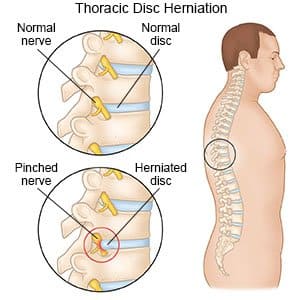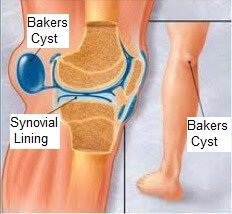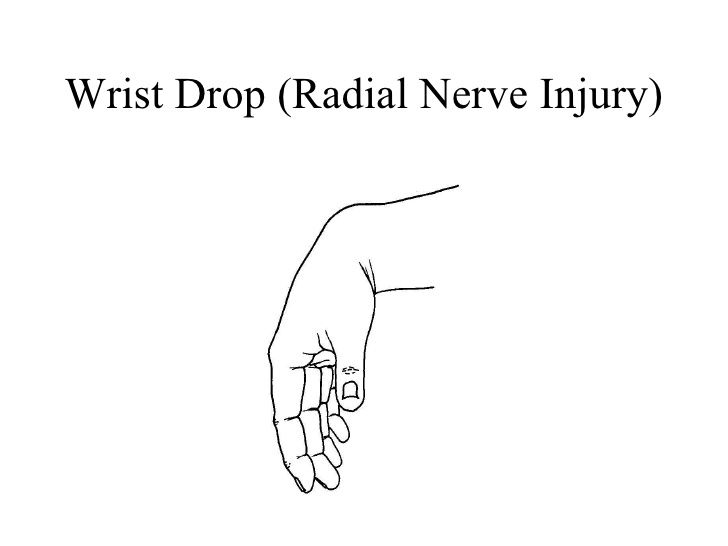Hip Hinge Exercises
Table of Contents
What is Hip Hinge exercise?
Hip hinge exercises are useful in many ways, especially to aid you with more advanced kettle bell and dead lift exercises. As we all know, mobility is extremely essential to have before completing exercises. You do not want to finish exercises that are out of the comfort zone of your muscles’ range of motion around the hip bones.
If you have ever been a member of a sports team, then you probably have heard the term ‘athletic position’. This pose is synonymous with the hip hinge. It needs that you keep your back straight and rest on your hips and heels. This position allows you to power through your motions using your posterior chain.
Hips and their hinges perform a lot of work to keep you upright and moving. Injuring this part could do some serious damage to the lower back and lumbar spine. The hip hinge is an exercise planned to primarily target the posterior chain, otherwise known as your backside. The muscles that make up the posterior chain involve the glutes, hamstrings, and low back. This exercise also relies on your core or abdominal muscles to assist in the motion.
Which are the Hip Hinge exercises?
Below is the long list of hip hinge exercises:
- Kettle bell Hip Hinge Drill
- Kettle bell Twisting Hip Hinge
- Over the shoulder Banded Hip Hinge
- The Age-Old Hip Thrust
- Camel Bridge
- Squat
- Goblet Squat
- Single Leg Dead lift
- Single Leg Dead lift with Kettle bell
- Romanian Dead lift with Barbell (No Weight)
- Romanian Dead lift with Dumbbells
- Good Mornings
- Kettle bell Bent Over Row
- Hip Thrusters
- Kettle bell Single-Legged Romanian Dead lift
- Kneeling 1-Side Loaded Hip Extension
- Double leg bridge
- Tall Kneel Raises
- Tall Knee Raises Against Band
- Banded Standing Hip Thrust
- Hip Hinge With Wall Touch
- Hip Hinge Latissimus Engagement
- Kettle bell Dead Lift
- Suitcase Dead Lift
- Hip Hinge with a Dowel
- Dead Bugs
- Dynamic Cat-Cow
- Kettle bell Swings
Kettle bell Hip Hinge Drill
The Kettle bell Hip Hinge Drill is a great exercise to get began with.
Line your feet shoulder-width apart and finish the basics. hip hinge motion to pick up your kettle bell.
Slight flex at the knees and your back straight.
When lifting, power through the lift utilizing your glutes until there is no bend in your knees.
While grabbing the kettle bell at both of the horns, rest the bottom of it just beneath the belly button, in between your hips. Then simply perform the hip hinge motion and power through it.
Kettle bell Twisting Hip Hinge
The simple hip hinge drill is a basic motion that can be modified into the kettle bell twisting hip hinge.
This is when you twist to the right or left as you move downwards through the motion.
The leg on the other side of the twist will take more flex than the leg on the side you’re twisting to.
You will also need to rest the kettle bell at the base of your sternum instead of your upper body.
Over the shoulder Banded Hip Hinge
First, stand on the resistance band and pull it over the shoulders.
Make sure to put the band over your shoulders and not over the back of your neck.
Keep the band between the forefinger and thumb, then complete the hip hinge motion.
The Age-Old Hip Thrust
The hip thrust is a relatively simple exercise where you place your back on an elevated surface and keep your feet flat on the floor.
All you do is utilize your core and your glutes to raise your torso from the seated position to where the shoulders, hips, and knees form a straight line.
You should bear the weight in the heels and your shoulders and keep your core engaged the whole time.
Flex the glutes as you push upward.
Camel Bridge
The camel bridge gives a great stretch for muscles involved in the hip hinge movement.
This will aid relieve glute, lower back, and thigh pain.
Sit on the knees with your legs apart shoulder width and your feet pointed behind you.
Sit back on the heels and then reach around and put your palms on your heels.
All you need to do is push forward to arch the body and create the ‘hump’ of the camel.
Squat
Stand up straight and brace the core.
Initiate the motion from your hips (butt going back).
Allow your upper body to move forward slightly, to counterbalance your hips.
Lower down to a 90-degree angle with your knees, or as low as comfortable for you.
As you lower down, externally rotate the knees.
Hold the down pose for 3 sec before coming up.
To come up, initiate the movement from the knees and then bring your hips forward.
Do it for 10 reps, 3 sets.
Goblet Squat
Grab a kettlebell (or dumbbell) in both hands and lock your shoulders.
Brace your core.
Initiate the motion from your hips (butt going back).
Allow your upper body to move forward slightly, to counterbalance your hips.
Lower down to a 90-degree angle with your knees, or as low as comfortable for you.
Hold the down pose for 3 sec before coming up.
To come up, initiate the movement from the knees and then bring your hips forward.
Go for 10 reps, 3 sets.
Single Leg Dead lift
Stand with resistance on one leg and brace your core.
Initiate the motion from the hip of your standing leg (butt going back).
The free leg (back leg) will rise slightly as you move forward.
Allow your torso to move forward slightly, to counterbalance your back leg.
When you’ve reached the depth that you’re comfortable with, utilize your knee and glutes to rise back up into starting position.
Go for 10 reps, 3 sets.
Single Leg Dead lift with Kettle bell
Stand with weight on one leg and grab a kettle bell in the opposite arm.
Press your shoulder blades down and lock your shoulders down.
Initiate the motion from the hip of your standing leg (butt going back).
The free leg (back leg) will rise slightly as you move forward.
Allow your upper body to move fwd slightly, to counterbalance your back leg.
When you’ve reached a depth that you’re comfortable with, utilize your knee and glutes to rise back up into starting position.
Go for 10 reps, 3 sets.
Romanian Dead lift with Barbell (No Weight)
Stand with feet just outside shoulder width.
Grab a barbell without weights, and externally rotate your shoulders (feel like you’re breaking the bar), to engage the lats.
Now begin hinging down from the hips (butt goes back).
Externally rotate the knees as you lower.
Keep a neutral spine the whole time.
Go down with barbell to mid-shin level.
Now utilize your knees and glutes to push off the floor and come up.
Squeeze the glutes when you stand up.
Romanian Dead lift with Dumbbells
Stand with feet just outside shoulder width.
Grab 2 dumbbells (one in each arm), and press your shoulders down.
Brace your core before you begin moving.
Now begin hinging down from the hips (butt goes back).
Externally rotate the knees as you lower.
Keep a neutral spine the whole time.
Maintain the dumbbells in front of you, and go down to mid-shin level.
Now utilize your knees and glutes to push off the floor and come up.
Squeeze the glutes when you stand up.
Good Mornings
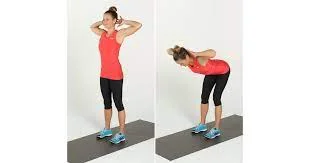
Stand with the feet in a neutral/comfortable stance, with a neutral spine and head straight.
Grab a weight behind your neck (barbell, kettlebell, or dumbbell), or, if you so choose, do this with just your body weight to focus on the range of motion.
Flex your knees slightly but keep your lower back straight as you hinge forward at the hips, with the weight primarily on your heels. Lower your torso until you’re close to a 90-degree angle.
Utilizing only the muscles in your hips and pelvis, push your torso back into the starting upright position.
Repeat as desired.
Kettle bell Bent Over Row
Stand with the feet in a neutral/comfortable stance.
Grab a kettle bell in one or both hands (unilateral or bilateral exercise).
Hinge forward at your hips until you’re at close to a 90-degree angle, your torso parallel to the floor.
Keep your weight on your heels, flex your knees a little, and push your hips backwards to assure your hamstrings, glutes, and hip hinge muscles are performing most of the work, not your lower back.
Row the weights up to the chest. You’ll have to engage your core to stay stable in this position but resist the urge to allow your lower back to round.
Keep your whole upper body aligned in a neutral spine position to concentrate the exercise on your hip hinge and lower body, not your lower back.
Resist the urge to allow your shoulder muscles to drop or hunch up toward your ears as you row.
Do a set of 10-15 reps, then carefully set the weights down and stand back up to your beginning position, using your hip hinge muscles to straighten rather than the lower back.
Hip Thrusters
Lay on your back on an elevated surface (bench or block) with your knees flexed and feet planted flat on the floor.
Use your glutes and core muscles to raise your torso, forming a straight line along your shoulders, torso, hips, and legs all the way to the knees.
Drive your heels down into the ground, and flex your glutes to push your hips as high into the air as you can.
Return to your beginning position (relaxed), and repeat as desired.
Kettle bell Single-Legged Romanian Deadlift
Stand with your weight balanced entirely on your leg, using your right leg to add support and balance as needed.
Hold a kettle bell in your right hand, and extend your left arm out to the side for balance.
Slowly hinge forward at the hips and lower the weight to gently tap the ground. Bend your left knee slightly to maintain your balance and keep the concentration on your glutes and hamstrings.
Use your hip hinge muscles, glutes, and hamstrings to stand back up, raising the kettle bell with you.
Repeat as desired, then switch hands and feet (weight in the left hand, balancing on your right foot).
Kneeling 1-Side Loaded Hip Extension
Kneel on a folded-up mattress or pad, with the back of the cable machine.
Utilize a D-handle to grip the cable securely in front of your waist (aim for the spot directly beneath your belly button), with the cable running alongside your right hip.
Hinge backwards to bring the butt close to your heels, then press the hips forward against the resistance of the cable to return to your starting position.
Repeat as desired, then switch sides (right hip, then left hip).
Double Leg Bridge
Starting on your back, pull your belly button inwards, squeeze your gluteals together and push through your feet to raise your hips upward.
Prevent arching the spine and keep your head neutral.
Avoid pushing the back of your head into the floor and focus on pushing through your feet.
Repeat 15 times.
Tall Kneel Raises
Beginning in the kneeling position with your feet pointed downward, pull your belly button inward and keep your shoulders back with the head neutral.
From the kneeling pose, move upward and forward to a tall kneeling position while keeping the neutral spine.
Repeat 15 times.
Tall Knee Raises Against Band
Beginning in the same position of kneeling, anchor a band to the wall or door and loop it around the waist.
Come into the same posture checkpoints of a neutral spine and move upward and forward against the band.
Prevent arching the lumbar spine.
Repeat 15 times.
Banded Standing Hip Thrust
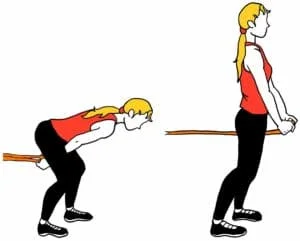
Once the hip extension is grasped in tall kneeling, progress to standing with the band around the waist.
Let the band pull your hips backward so you flex at the crease of your pants while also concentrating on keeping your knees behind your toes.
Your knees flex, but only to allow you to push your hips back further.
Keep the neutral spine checkpoints from the tall kneeling drill.
Once in the full hip hinge pose, move your hips forward against the band.
Keep the neutral spine and avoid arching the lumbar region.
Permit the band to pull your hips back to the starting position.
Repeat 15 times.
Hip Hinge With Wall Touch
Utilizing a wall or an exercise ball is a great tactile feedback method to aid promote proper posterior weight shift.
Beginning in the standing position, put a dowel or a pole behind your back so that it touches the back of your head, in between the shoulder blades and your tailbone.
Keeping all three points of contact, push your hips back so they touch the wall.
The same method can be performed with an exercise ball.
Maintain a neutral spine and prevent arching the lumbar spine. Maintain the knees behind the toes.
Repeat 15 times.
Hip Hinge Latissimus Engagement
Begin by standing with your opposite hand on one of your latissimus muscles. This is found on the outer side of the armpit and runs down along your ribs.
Holding your hand there, practice squeezing your scapulae back and down against your body.
It may aid to put a towel between your arm and the side of your torso to squeeze.
Repeat 15 times.
Kettle bell Dead Lift
To lift resistance from the ground, all the movements from the prior drills will be applied in one fluid sequence with the raise.
Starting with the weight propped up on a stool permits for an easier start position until you get comfortable with raising the weight further down.
With a kettle bell or dumbbell on a stool, step as close as possible, preferably with the feet around the stool.
The closer you are to the object, the less lever arm it is for the back.
With your hips pushed back in the hip hinge pose, grasp the weight and execute the lat squeeze drill so your scapulae are back and down pressed against the body.
In one motion, keep the arms straight and locked, press your feet to the floor and move your hips forward to raise the weight.
Think about pushing the floor down under your feet while keeping your shoulders locked in place.
On the way back down, begin by pushing your hips back into the hip hinge to counterbalance the weight.
Suitcase Dead Lift
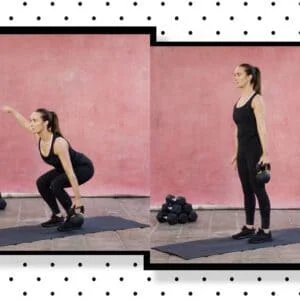
Place a dumbbell on the ground and stand next to it so that the handle runs parallel to your feet. Stand with the feet about hip-width apart.
Squat down and grab the dumbbell with an overhand grip, so your thumb is pointing forward. Straighten the arm.
Drop your hips, raise your chest, and slightly arch your lower back. Look straight ahead and brace your abs.
Without rounding the back or leaning to the side, drive your feet to the ground and stand up. Keep your abs braced, working hard to keep your upper body perfectly upright.
Push your hips back, flex your knees, and lower the weight smoothly back to the floor. Reset the core and repeat.
Rest a moment at the end of your set and then switch sides. Try to perform the same number of reps on each side.
Hip Hinge with a Dowel
Stand with feet shoulder-width apart while grabbing a dowel. A broomstick will also work if you’re performing hip hinge exercises at home. Put the dowel behind your back in alignment with your spine.
Grab the top of the dowel to the back of your head. With your other hand, grab the dowel at the base of your spine so that the back of your hand is touching the lower back. This is the starting position.
Brace your core, and exhale as you pull the hips backward, allowing your weight to transfer to your heels. Allow only slight motion in your knees.
As your hips transfer back, allow your torso to flex in half toward the floor. As you move, the dowel should stay in contact with your head and your hand should still be touching the lower back. If your back begins to round, correct your posture, and make a note of the compensation.
Pause approximately halfway between being upright and fully parallel. Slowly reverse the motion, maintaining contact with the dowel as before. Squeeze the glutes to engage the posterior chain as you stand upright.
Repeat this exercise daily as a part of your warm-up. The more you practice correcting your form with the dowel, the better your muscle memory will become when raising weights.
Dead Bugs
Lay on your back on the ground with your arms stretched overhead and your legs extended.
Engage your core and tilt the pelvis so that your lower back is flush against the ground. It should stay like this for the duration of the motion.
Bend your knees and raise your legs so that your calves are parallel to the floor. Lift your arms toward the roof so that they are perpendicular to your body. This is your starting position.
Take a breath and slowly lower and extend your left arm and right leg. Hover about an inch from the floor for three seconds before slowly returning to the beginning position.
Repeat with the right arm and left leg. That’s one rep.
Slow and controlled motion is essential for this core and hip engagement exercise. Concentrate on moving through the range of motion while keeping your lower back neutral and flush to the ground.
Dynamic Cat-Cow
Get into a quadruped position on the ground, with hands stacked beneath the shoulders and knees hip-width apart.
Brace your core, and round your scapulae while letting your chin fall to your chest. Concentrate on stretching your cervical spine during this portion of the motion.
Maintain this position while permitting your hips to hinge back until you are sitting on your legs. Your lumbar spine should stay neutral with your pelvis tucked.
Pause, then pull back up into quadruped, letting your lumbar spine drop and shoulder blades pinch together. Raise your chin from your chest and look ahead.
Repeat the movement in a slow, controlled flow for 30 seconds to one minute.
Controlling motion and building body awareness is the goal of this exercise. The shortened hip hinge can also aid you in learning to control the lumbar spine while transferring backward.
Kettle bell Swings
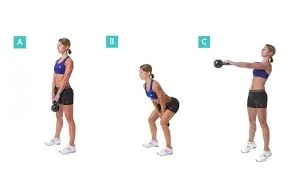
Set a kettle bell on the ground and stand slightly in front of it with feet outside of shoulder width. The broader stance is crucial for making this work.
Hinge your hips and reach through your legs to grab the kettle bell.
Utilize your hips to swing the kettle bell forward until it reaches eye level. Contract your glutes at the top of the motion. Your arms should stay locked throughout the action; the hips drive the movement.
Control the descent as you bring the kettle bell back down between the legs, reaching slightly behind you.
Without allowing the kettle bell to touch, repeat the motion.
Beginning slightly ahead of the kettle bell rather than with it in front of you permits you to start in the proper hip hinge position. You can also let the kettle bell go directly overhead for a fuller range of motion.


